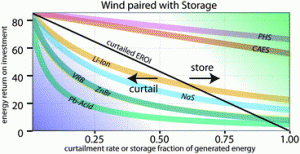Researchers compare the energy return on energy investment (EROI) ratios of electricity storage versus curtailing electricity production for renewable, but variable, resources.
Wind and solar power are current leaders in renewable energy resources, but pose a challenge to more widespread use because of their variable, weather dependent nature. Currently, wind and solar energy harvesting is curtailed during times of oversupply, resulting in a forfeiture of energy. A clear solution to keep from losing all of this energy would be to store it for later use; however, storage can come at its own energetic cost that is often greater than the gain of the energy stored.
In a recent EES paper, Barnhart et al. examined the EROI ratios for methods of energy storage and compared the ratios with those during curtailment of electricity production for solar and wind power generation. Specifically, they explored electrical energy storage through both battery and geologic storage technologies, and compared the electrical cost of those storage methods to curtailment energy losses.
Barnhart et al. found that, depending on the type of energy resource, usage patterns, and storage type, there are cases in which it is more energetically favorable to store excess electricity, and cases in which it is more favorable to curtail the resources. Conventional battery technologies did not perform well in terms of energy cost compared to geologic storage technologies. Based on these findings, the authors recommend focusing on ways to improve battery EROI ratios, such as improving cycle life, as the next step toward developing electricity storage in which the energy cost is less than loss incurred from curtailment of electricity generation.
This paper recognizes that wind and solar energy are becoming more widely used and are proving to be excellent resources, which is great news from the perspective of reducing carbon usage in electricity production. But it is clear from the findings, as well as from a practical standpoint, that energy storage needs to be the next step for an increase in usability of these resources. These power generation technologies continue to grow, but due to variability, production does not always match with consumer usage patterns. Wouldn’t it be great, from the perspectives of both affordability and sustainably, to be able to run your appliances with solar power at night, or with wind power on a still day? Energy storage that is cost-effective from an energy expenditure standpoint is clearly the next step in paving the way for more widespread use of these sustainable, low-carbon energy resources.
Learn more about this analysis in the full EES article here:
The energetic implications of curtailing versus storing solar- and wind-generated electricity
Charles J. Barnhart, Michael Dale, Adam R. Brandt and Sally M. Benson
Energy Environ. Sci., 2012, 5, 8430
DOI: 10.1039/c2ee21581k










